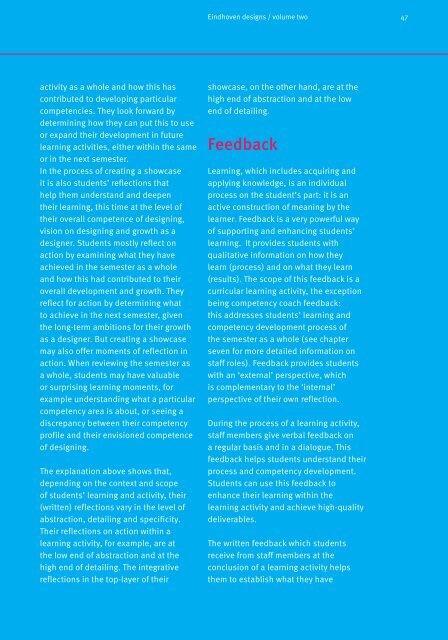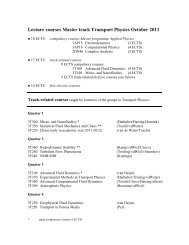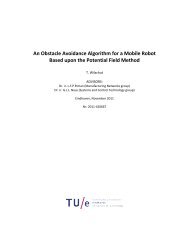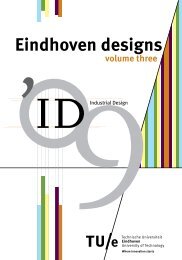Education guide 'Eindhoven designs' - Technische Universiteit ...
Education guide 'Eindhoven designs' - Technische Universiteit ...
Education guide 'Eindhoven designs' - Technische Universiteit ...
You also want an ePaper? Increase the reach of your titles
YUMPU automatically turns print PDFs into web optimized ePapers that Google loves.
Eindhoven designs / volume two<br />
47<br />
activity as a whole and how this has<br />
contributed to developing particular<br />
competencies. They look forward by<br />
determining how they can put this to use<br />
or expand their development in future<br />
learning activities, either within the same<br />
or in the next semester.<br />
In the process of creating a showcase<br />
it is also students’ reflections that<br />
help them understand and deepen<br />
their learning, this time at the level of<br />
their overall competence of designing,<br />
vision on designing and growth as a<br />
designer. Students mostly reflect on<br />
action by examining what they have<br />
achieved in the semester as a whole<br />
and how this had contributed to their<br />
overall development and growth. They<br />
reflect for action by determining what<br />
to achieve in the next semester, given<br />
the long-term ambitions for their growth<br />
as a designer. But creating a showcase<br />
may also offer moments of reflection in<br />
action. When reviewing the semester as<br />
a whole, students may have valuable<br />
or surprising learning moments, for<br />
example understanding what a particular<br />
competency area is about, or seeing a<br />
discrepancy between their competency<br />
profile and their envisioned competence<br />
of designing.<br />
The explanation above shows that,<br />
depending on the context and scope<br />
of students’ learning and activity, their<br />
(written) reflections vary in the level of<br />
abstraction, detailing and specificity.<br />
Their reflections on action within a<br />
learning activity, for example, are at<br />
the low end of abstraction and at the<br />
high end of detailing. The integrative<br />
reflections in the top-layer of their<br />
showcase, on the other hand, are at the<br />
high end of abstraction and at the low<br />
end of detailing.<br />
Feedback<br />
Learning, which includes acquiring and<br />
applying knowledge, is an individual<br />
process on the student’s part: it is an<br />
active construction of meaning by the<br />
learner. Feedback is a very powerful way<br />
of supporting and enhancing students’<br />
learning. It provides students with<br />
qualitative information on how they<br />
learn (process) and on what they learn<br />
(results). The scope of this feedback is a<br />
curricular learning activity, the exception<br />
being competency coach feedback:<br />
this addresses students’ learning and<br />
competency development process of<br />
the semester as a whole (see chapter<br />
seven for more detailed information on<br />
staff roles). Feedback provides students<br />
with an ‘external’ perspective, which<br />
is complementary to the ‘internal’<br />
perspective of their own reflection.<br />
During the process of a learning activity,<br />
staff members give verbal feedback on<br />
a regular basis and in a dialogue. This<br />
feedback helps students understand their<br />
process and competency development.<br />
Students can use this feedback to<br />
enhance their learning within the<br />
learning activity and achieve high-quality<br />
deliverables.<br />
The written feedback which students<br />
receive from staff members at the<br />
conclusion of a learning activity helps<br />
them to establish what they have

















